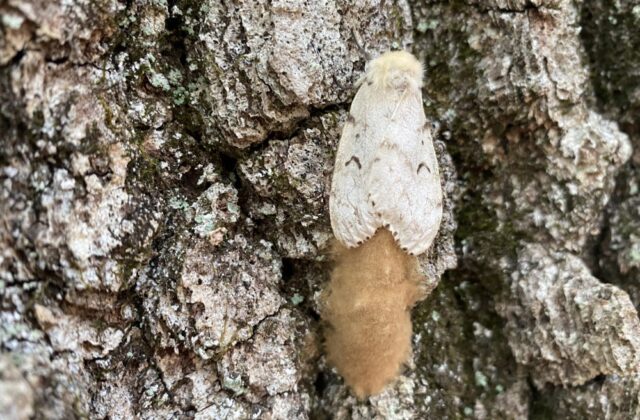Prepare Now to Combat the Next Spongy Moth Season
Defending Norfolk’s Trees
By Susannah Wood
Last year an outbreak of spongy moth (Lymantria dispar) caterpillars arrived in the Northwest Corner, defoliating the trees and turning entire hillsides back to early spring again. Norfolk forests suffered significant damage from these exotic pests, formerly known as gypsy moths. Towns to the west were even harder hit.
Healthy deciduous trees can be largely defoliated in spring, leaf out again in summer and survive, but it does stress them. While trees can withstand one or two such defoliations, several bad years of infestation can cause trees to die, especially if drought occurs. The caterpillars will also feed on conifer needles, particularly when there are very large infestations. Evergreen trees cannot resprout needles later in the summer and may be killed by a single defoliation.
The outbreak in this area might well have been worse without wet spring weather which spurred the growth of a fungal pathogen (Entomophagamaimaiga) deadly to the caterpillars. Another pathogen may also have helped, a virus known as NPV. (Caterpillar victims of the virus die in a V formation.) Neither of these pathogens affects people or beneficial insects. It was certainly encouraging to see the trunks of oak trees covered with dead caterpillars as the summer progressed. Once the caterpillars become adult moths, their life cycle is nearly complete. The males and females mate; then the flightless females lay tan, spongy-looking egg masses, usually on the bark of an oak tree (though also on other species such as maples and apple trees) and then die.
So how to stop the infestation? Reducing the number of caterpillars will lessen the damage they inflict. Since each egg mass contains anywhere from 100 to 1,000 eggs, destroying them is more efficient than waiting until the eggs hatch. Also, killing the eggs manually or with an oil and soap spray has no environmental downside. Over these next couple of months, before the caterpillars hatch out (generally late April to early May), walk property and forest trails armed with a small plastic container, bag or can and something to scrape with, like a pocket or putty knife. Look for the fuzzy, tan egg masses on the tree trunks. They may be dotted with small pinholes, a sign that tiny parasitic wasps have been at work. Carefully scrape the egg mass into the container. Take the eggs home—if left on the ground, they remain viable—and either burn them, cover them with soapy water for two days or drench them with a spray of horticultural oil or insecticidal soap. Also check for moth eggs on siding, vehicles, bricks, firewood and under eaves.
Since the fungus that kills the caterpillars needs moisture to develop, pay attention to rainfall in May and early June as the growing season takes off. If the weather is dry, it is a good idea to water any yard trees needing protection. Carole Cheah of the Connecticut State Experiment Station recommends a gallon of water around the base of the tree once a week. She also says that once the caterpillars appear, if they aren’t attacked by the fungus, another approach is to find dead caterpillars nearby and grind these into a slurry with water to spray around trees to inoculate them with the fungus. The station is a good source of information on both outbreaks and defense strategies.
Once the caterpillars hatch out, make a trap by wrapping trees with a wide piece of burlap, tying it in the middle of the cloth so a flap hangs over the string or rope. Older caterpillars generally want to hide in the shade during the day, climbing back up to feed at night. The burlap flap will seem like a good place to hang out. Shake them into a bucket of soapy water before nightfall. Duct tape can also be wrapped around the trunk, sticky side out, smeared with Tanglefoot or petroleum jelly. Do not put the Tanglefoot on the bark of the tree itself. Make sure to redo the strips frequently or the traps will lose effectiveness.
It’s best to avoid spraying the trees with any chemicals, even those sold as benign. Many such products require a licensed applicator; find a list of arborists on the website of the Connecticut Tree Protective Association (CTPA.org). After an outbreak, making sure that trees get about an inch of water a week throughout the summer and early fall will help them recover.

